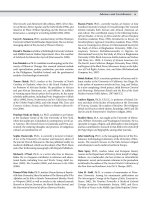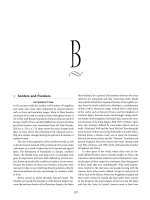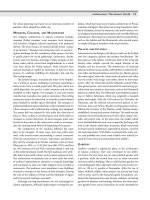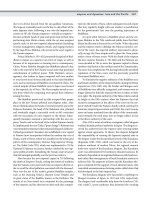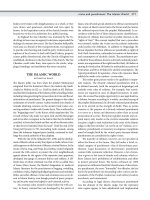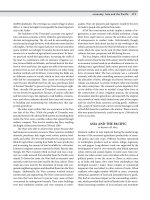Encyclopedia of society and culture in the medieval world (4 volume set) ( facts on file library of world history ) ( PDFDrive ) 242
Bạn đang xem bản rút gọn của tài liệu. Xem và tải ngay bản đầy đủ của tài liệu tại đây (46.87 KB, 1 trang )
climate and geography: Africa 215
The termination of the Medieval Warm Period may have
been in part caused by variations in solar radiation, or energy
coming from the sun. Short-term and long-term variations
in solar radiation have always occurred, as associated with
numbers of sunspots, and the Little Ice Age has been associated with a 70-year period of minimum sunspots. Another
contributing factor may have been an increase in volcanic activity. The sulfur dioxide released during volcanic eruptions
travels high into the stratosphere and forms sulfate aerosol,
which acts to reflect solar radiation back into space before
it has a chance to warm the earth, resulting in cooler global
temperatures. Thus, even if no increase in volcanic activity in
Africa near the end of the Medieval Warm Period has been
observed or recorded, volcanic activity elsewhere on the globe
could have triggered cooler temperatures in parts of Africa;
indeed, one such event took place in Iceland in 1175.
Humans within the Environment:
The Effect of Trade
Human settlements molded and were molded by their environments with regard to numerous geographic and climatic
factors during medieval times. Such factors included rainfall,
soil type, ecological variations, and availability of natural
resources. Interactions between humans and their environments were largely shaped by increases in the number of and
contact among cultures that were growing increasingly complex and sophisticated.
One of the major human activities of the medieval period in Africa was the trans-Saharan trade. This extensive
network was driven by the continent’s wealth of valued natural resources, including gold, salt, and ivory, as well as by
the transport and exchange of slaves. As the Sahara had returned to desert conditions long before the medieval period,
nomadic Berber people who were native to the Sahara region
had extensive knowledge of survival in that climate and landscape. The brief and minor humid phase that began in the
middle of the first millennium c.e. led humans living in the
Sahel to move north toward the Sahara, where they interacted
more intimately with Berbers and Arabs, who were in turn
traveling farther and farther south, ultimately reaching Sahel
regions by the year 600. During this period population centers developed in the drier regions, serving as stopover locales
for the long-distance Saharan caravans.
Berbers became essential contributors to trans-Saharan
trade, leading the long and large camel caravans that crossed
the desert to trade Africa’s natural resources with Arab, Mediterranean, and eventually European peoples. The original
introduction of the camel into regional trade activity in the
third or fourth century c.e. dramatically changed human patterns in the context of the very harsh landscape. In the centu-
ries that followed, trade routes blossomed and allowed for the
rise of great civilizations based on the exploitation of Africa’s
natural resources. The economies of the medieval Ghana Empire (eighth to mid-13th centuries), from which arose those
of the Mali empire (beginning ca. 1100), from which arose
those of Songhai (mid-15th to late 16th centuries), were based
on the wealth gained from the trade of gold, salt, slaves, ivory,
kola nuts, copper, leather, rubber, iron, cloth, and other items.
Trade across the Red Sea with Arabia also expanded during
this time period. The civilization of Axum, in northeastern
Africa, traded in ivory, slaves, and other natural resources
with Arab seamen.
Rise
and
Fall
of
Civilizations
The rise and fall of great African empires often can be attributed to geographic and climatic causes. The moderately
sized trade city of Adulis, on the Eritrean coast, outgrew its
water resources and was moved to the nearby highlands of
northern Ethiopia, becoming the city of Axum. This city
prospered in part as the result of favorable climatic conditions that graced the area with two rainy seasons, allowing
for two farming seasons each year. As the population expanded, forests were cleared for settlement, agriculture, and
iron smelting. Over time, excessive cropping led to soil erosion and declining soil fertility. The final blow to the region
was a decline in rainfall around 750. These factors led to the
demise of the civilization by 800.
The Ghana Empire, in present-day Mauritania and Mali
(and bearing no connection with present-day Ghana), was
founded and flourished based on the region’s rich gold mines
during the first millennium c.e. Many factors have been cited
as contributing to its fall, including population growth that
stripped the region of natural resources, drought, and conflict with outside groups. The people of Ghana enjoyed relatively favorable rainfall between 300 and 1100. However, a
regional drought in 1100 made the successful raising of cattle
and sheep difficult. Furthermore, economically Ghana relied on its control of gold in the trans-Saharan trade; around
1200, gold mines opened up elsewhere, also contributing to
the civilization’s decline. By 1235 the Ghana Empire no longer existed.
As Ghana declined, the Mali Empire became a main force
in the trans-Saharan trade of gold and salt. At its height in the
14th century the empire stretched from the Atlantic outlet
of the Senegal River some 1,250 miles inland, east of Timbuktu. Climate change assisted growth in trade and wealth
for the empire: During the dry period from 1300 to 1450 Malian peoples were able to access areas rich in gold that had
previously lain well within the wet habitat of the tsetse fly,
which carries a deadly disease known as sleeping sickness. At

